The post Understanding Digital Service Management: Essential for ITSM Excellence appeared first on Vyom Labs.
]]>In the ever-evolving landscape of Information Technology Service Management and operations, the concept of Digital Service Management (DSM) has emerged as a crucial element for organizations striving for excellence in IT service delivery. With the increasing importance of digital technologies and the need for effective IT services, implementing DSM is now imperative rather than optional. This article will explore what DSM is, why it is essential for ITSM excellence, and how organizations can leverage it to stay ahead in the digital era.
What is Digital Service Management (DSM)?
DSM is the evolution of IT Service Management (ITSM) in response to the digital transformation sweeping across industries. While ITSM is traditionally focused on managing and delivering IT services to support business operations, DSM extends this concept to encompass the broader spectrum of digital services. These services encompass a wide array of digital technologies, including cloud computing, cybersecurity, AI and machine learning, DevOps, and more.
In essence, DSM is a holistic approach that aligns IT services with the organization’s broader objectives and leverages digital technologies to enhance service delivery, improve customer experiences, and drive business outcomes.
Why DSM is Essential for ITSM Excellence
- Enhanced Agility: In today’s digital age, businesses must be agile and responsive to evolving market conditions and customer needs. DSM enables IT departments to be agile by streamlining service delivery processes and facilitating rapid response to emerging business needs.
- Improved Customer Experience: DSM focuses on the end-to-end customer journey. It ensures that digital services are reliable and user-friendly, leading to higher customer satisfaction and loyalty.
- Optimized Resource Utilization: DSM helps organizations maximize their IT resources by automating routine tasks, minimizing downtime, and optimizing infrastructure utilization.
- Cost Efficiency: DSM can save costs in the long run by automating tasks and reducing manual intervention. Moreover, it allows organizations to allocate resources where needed most efficiently.
- Better Risk Management: In the era of cyber threats and data breaches, DSM emphasizes robust cybersecurity practices and ensures that digital services are resilient to attacks. It helps organizations proactively manage and mitigate risks.
- Data-Driven Decision Making: DSM leverages data analytics to provide insights into service performance and user behavior. This data-driven approach enables organizations to make informed decisions, improve service quality, and identify areas for continuous improvement.
- Alignment with Business Goals: DSM aligns IT services with the strategic goals of the organization. It ensures that IT is not just a cost center but a strategic enabler of business growth and innovation.
Implementing DSM Successfully
To harness the benefits of DSM and achieve ITSM excellence, organizations should consider the following steps:
- Assess Current State: Begin by evaluating your current ITSM practices and digital service offerings. Identify areas needing improvement and determine your organization’s goals and objectives.
- Define Service Catalog: Create a comprehensive catalog of digital services, including their dependencies and interconnections. This will serve as the foundation for DSM implementation.
- Automation and Orchestration: Implement automation and orchestration tools to streamline service delivery processes. This includes automating routine tasks, managing configurations, and ensuring consistent service quality.
- Cybersecurity Integration: Integrate robust cybersecurity measures into your digital services from the outset. This includes continuous monitoring, threat detection, and incident response planning.
- User-Centric Design: Design digital services with the end-user in mind. Ensure user interfaces are intuitive and that user feedback is actively incorporated into service improvements.
- Performance Analytics: Utilize data analytics and monitoring tools to track the performance of digital services. Use this data to identify bottlenecks, service degradation, and areas for optimization.
- Continuous Improvement: Implement a culture of constant improvement. Encourage user and IT staff feedback, and regularly review and update your DSM practices.
- Training and Skill Development: Invest in training and skill development for your IT team. DSM requires a deep understanding of digital technologies and evolving best practices.
Conclusion
In a world where digital technologies underpin almost every aspect of business operations, Digital Service Management is not just a buzzword; it’s a strategic imperative. To achieve ITSM excellence, organizations must embrace DSM as the path forward. Organizations can thrive in the digital era and stay ahead of the competition by aligning IT services with business objectives, optimizing processes, enhancing customer experiences, and proactively managing risks.
About the Author:
 Shomit Mitra
Shomit Mitra
B2B SaaS Marketing Expert | Digital Transformation Evangelist
With more than a decade of experience and expertise in initiating digital transformative initiatives in virtually every domain, Shomit has a knack for identifying potential opportunities for process improvement through modernization.
The post Understanding Digital Service Management: Essential for ITSM Excellence appeared first on Vyom Labs.
]]>The post ITSM Powered by Artificial Intelligence appeared first on Vyom Labs.
]]>IT Service Management is one of the top priorities of virtually leading business that is heading toward becoming Autonomous Digital Enterprise. This demands constant innovation and the adoption of agile and effective strategies to operate while providing an exceptional customer experience. According to research conducted by IDC [1], enterprises will be expected to deliver more services than they did in the last 40 years. So to scale your business to meet the growing demands, it is vital to harness the potential of AI.
The prospect of investing a significant sum into AI seems like a blind leap of faith at first. And to address that Forrester researched to gauge the costs and benefits. And the results were surprising.
The financial analysis of Forrester found that by adopting AI and automation in ITSM tools like the BMC Helix, the return on investment was found to be 361%.
AI-Powered Service Management – The centerpiece of a bigger puzzle
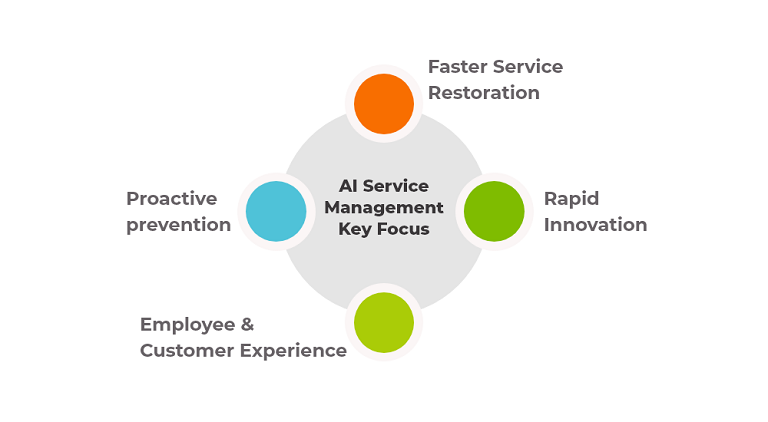
AI-powered service management is filling in some of the most significant gaps present in the traditional ITSM approaches and methodologies. As compared to a more reactive approach of conventional ITSM, with AI involved, we can aim towards a predictive, preventive, and proactive approach. That enables your IT teams to focus on innovation, employee experience, and rapid service restoration.
Addressing the elephant in the room with AI-powered Service Management
To deliver standard-setting delivery of services, the key is to eliminate the dependencies and serial processes. And the first step toward solving a problem is knowing that there is a problem in the first place. Traditional ITSM presents us with the following challenges.
- The traditional approach is reactive which means that teams resort to knowledge base articles, more experienced staff, or even make educated guesses to identify and analyze the problem.
- The conventional approach falls short on the scalability front.
- With insufficient time to perform the root cause analysis of the problem, chances are quite high of your teams temporarily restoring services caused by the same problem multiple times.
A smoother, faster, and smarter way forward

Providing the best possible CX & EX needs immaculate execution of the operational strategy. And to do that, the AI makes use of automation to harvest every ounce of value from the tech infrastructure and make the most out of the strategy. Initiating such a transition could be a daunting proposition, so here are some great places to start.
1. Service Automation
With the right tools and tech, automation can work wonders. You can use automation to tackle complex processes as well.
- With enough historic data, it is possible to identify patterns in aggregate data.
- Faster & improved self-service.
- Significantly reduced investigation time & MTTR.
2. Managing core enterprise services
A growing enterprise thrives on best practices. That is where the concept of enterprise service management or ESM comes into the picture. It refers to the application of all the aspects of ITSM to help improve other processes. And with AI and ML, it is possible to get quicker ROI, increased productivity, minimal wastage of resources, significantly enhanced visibility & control along with increased user satisfaction.
3. Improved DevOps
AI and ML can be utilized in advanced analytics to detect anomalies, automated deployment, and optimized service quality using predictive analysis. That allows for faster innovation and helps your enterprise gain a competitive edge over others.
Conclusion
It is evident that the applications of AI and ML are only going to go up in the upcoming years. Innovation and digital transformation are at a staggering pace. With AI-powered ITSM, businesses can get the maximum value out of their digital strategies, data, and technological infrastructure to provide the best possible experience to employees and customers. In the grand scheme of things, it’s a win-win situation for everyone.
About the Author:
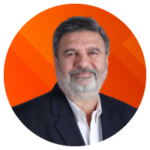 Prashant Deshpande
Prashant Deshpande
Executive Vice President
Prashant heads global delivery of Vyom Labs consisting of various practice units such as BMC and ServiceRize. Prashant has illustrious career over thirty years in information technology and has served at senior executive levels with global companies such as: IBM, BMC, Veritas and Citibank.
Prashant has built, scaled and managed various IT, professional services & product development/support organizations.
His technical expertise is in IT infrastructure management, automation and managed services. He is passionate about business transformation using cognitive technologies such as AI and machine learning.
The post ITSM Powered by Artificial Intelligence appeared first on Vyom Labs.
]]>The post AI in Service Desk Management – The Next Big Thing appeared first on Vyom Labs.
]]>The term AI is thrown around quite frequently in various tech communities. And it is for a very good reason. According to BMC Software, the cost of manually handling a service desk ticket is around $22. But with automation, almost 22% of these tickets can be resolved at no cost. Thanks to this disruptive and innovative concept, the picture of service desk management will go through drastic improvements.
Research by Gartner shows that by 70% of white-collar workers will interact with some form of chatbot by 2022.
A variety of strategies and technologies branch out from the term “intelligent automation”. Some of the terms that come under this umbrella include rapid-automation technologies (i.e., robotic process automation [RPA] software or scripting), artificial intelligence (AI) approaches such as deep learning, machine learning, natural language processing, speech recognition & synthesis, machine vision, and machine reasoning.
Managing service desks using AI-driven features like chatbots and self-service
We have been using self-service in its most basic form as a knowledge base, but the sophistication has just begun. With chatbots and AI-powered search recommendations, arriving at the right solution is much faster and easier. Using powerful AI features like predictive analysis, IT teams can better manage incidents and resolve tickets effectively and more efficiently.
Here are three key areas where AI can be leveraged to get maximum value addition for your business.
- Chatbots
- knowledge management
- incident/request auto-routing.
Some of the most basic chatbots run on NLP [natural language processing] that allows for conversation.
This can be used to carry out a targeted search of the knowledge base or answer faq-type queries. This capability of improved AI-powered search can also be extended to take further actions based on user inputs using RPA technology. Simple tasks like simple password resets and the creation of VMs in the private or public cloud can be just as easily automated. Using the auto-resolution feature, IT teams can speed up various processes and tasks by removing the manual overhead associated with high-volume and low-value service desk activities.
It could be tedious for a help desk agent to route incidents and request tickets to a proper support group. However, using AI it is possible to automate auto-classifying, prioritizing, and routing incidents or service requests to appropriate support groups.
AI-assisted knowledge management is proving to be a new step toward smart service desk management. AI-powered knowledge management includes an intelligent search function that goes beyond a set of specific keywords and understands the context and meaning. This means that search results are more relevant.
Auto Responding – The New Way Forward
Imagine this, users can now receive most likely solutions which are generated by auto-responders that are powered by AI. The AI managing the knowledge base can also keep track of previous interactions and other behavioural patterns. Using that data, it can make relevant suggestions regarding actions to be performed based, on managing incidents, changes, problems, and known errors. When the AI has enough data, it can even perform self-healing activities using all the data on previous engagements.
Like any other technical vertical, support-level responsibilities are evolving as well. Here’s what the spectrum of support levels looks like according to Gartner:
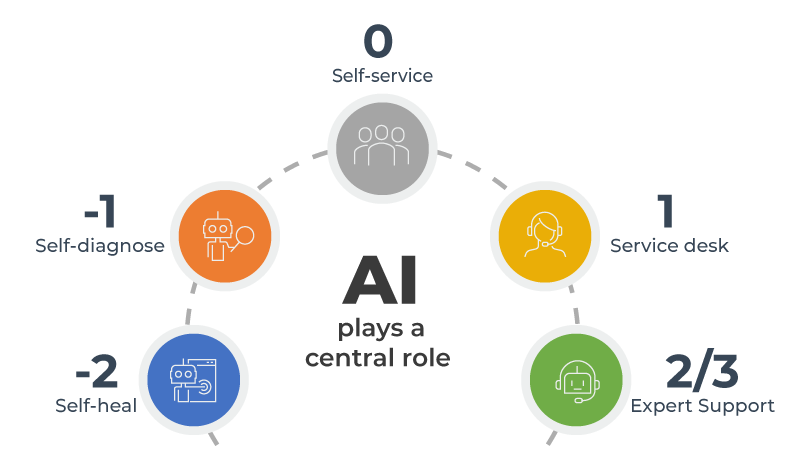
This proves that AI plays a central role in service desk automation to enable vital activities like self-service, self-diagnostics, and self-healing.
A study by Gartner shows that 75% of issues on average (service requests, common software issues, password resets, “how to” questions, and outage notifications) have the potential to be resolved without requiring Level 1 or higher support (i.e., “Level 0 solvable”)
This massive shift in paradigm enables current support staff to do more complex operations at L3 levels by freeing them from performing low-level, mundane tasks.
It is safe to conclude that AI can help reduce overall operating costs, improve user experience, increase agent productivity, help forecast IT issues, identify problems, manage changes better, and improve key metrics including resolution times and SLA compliance level.
About the Author:
 Prashant Deshpande
Prashant Deshpande
Executive Vice President
Prashant heads global delivery of Vyom Labs consisting of various practice units such as BMC and ServiceRize. Prashant has illustrious career over thirty years in information technology and has served at senior executive levels with global companies such as: IBM, BMC, Veritas and Citibank.
Prashant has built, scaled and managed various IT, professional services & product development/support organizations.
His technical expertise is in IT infrastructure management, automation and managed services. He is passionate about business transformation using cognitive technologies such as AI and machine learning.
The post AI in Service Desk Management – The Next Big Thing appeared first on Vyom Labs.
]]>The post Future of Intelligent Service Management appeared first on Vyom Labs.
]]>What does the future of BMC Helix look like?
Technology as we know it is evolving faster than life on Earth. What started out as IT Service Management has also gone leaps and bounds ahead. But with time business needs also evolve. No technology can afford to fall behind when the global market is constantly asking “What’s next?” But when it comes to BMC Helix, it’s time businesses step into the future and become cognitive enterprises.
Becoming a cognitive enterprise with BMC Helix
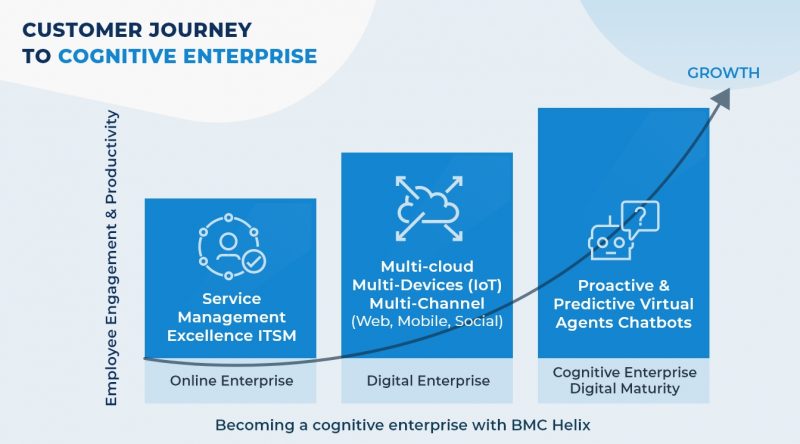
A cognitive enterprise is an organization that harnesses every ounce to enable its employees to work on unimaginable productivity levels. But to do that AI and Machine Learning alone won’t get you there. Such enterprises focus on delivering seamless experiences, building a deep connection with their customers, and then leveraging technology along with the OODA model (Observe-Orient-Decide-Act). Speaking of such tech, the BMC Helix software to this very day continues to deliver autonomous, data-driven, and customer-centric experiences across various channels. To make it happen, it uses these components.
1. System of engagement
This is the outer-most layer of this experience delivery mechanism. This is where the customer interacts with your enterprise through various channels like chatbots, virtual support agents, slack, or directly via mobile device. The interaction then goes into the system of record.
2. System of record
This is where the BMC Helix software suit comes into the picture to store the interaction data.
System of intelligence
This is the cognitive center that rummages through the data to learn and make predictions powered by an AI.

Cognitive Automation
So what is cognitive automation? It is a collection of different methodologies and various approaches we take towards combining AI with other process automation capabilities for the increased outcome. BMC Helix plays a pivotal role in establishing cognitive automation. It can be integrated with AI Watson by IBM Watson, Amazon Lex, and Microsoft Cortana among others. To make agent-efficient processes it offers auto-classification and auto-assignment options. With cognitive automation, we are looking at a future where business processes are simpler, faster, and cost-effective.
With such cutting-edge technology, enterprises can significantly reduce the admin workload. By incorporating AI, ML, and NLP, businesses can make the most of cognitive automation and digital transformation for an efficient tomorrow.
Cognitive Service Management with BMC Helix
There is no denying the fact that digital transformation is inevitable. And Service Management is growing and evolving at an equally staggering rate. Here’s what IT Enterprise trends have to say about digitization.
- Gartner predicts that more than 75% of Global Enterprises will be using containers like AWS, Microsoft Azure, and BMC by 2022.
- Research suggests that the ITSM market has the potential to grow by a staggering margin of USD 11.51 billion during 2021-2025.
- Studies indicate that the value of global e-commerce transactions through chatbots will reach USD 112 billion by 2023.
Here’s where BMC Helix comes into the picture. It seamlessly blends human expertise with the speed, efficiency, and accuracy of the technology. The ITSM suite enables enterprises to run on cloud technology and even on multi-cloud environments. With multi-cloud service management companies would be able to broker tickets and incidents by integrating AWS and JIRA. Sounds too good to be true? But this is not just a matter of fiction anymore we are already on the path towards the inevitable digital tomorrow and the path is paved with intuitive technology.
Conclusion:
The paradoxical part of this discussion regarding the future of ITSM is that it’s already here. These are just a few of the advancements that we have been seeing among many others. This promises an optimistic approach towards what we can expect in the future from BMC Helix. Hence by embedding digital tech into service delivery processes, companies can now reduce costs while increasing accuracy and efficiency.
We at Vyom Labs take pride in helping companies not only initiate the digital transformation but accompany them at every stage to help them increase the value of their business. Having worked closely with BMC’s R&D and engineering teams, nothing would delight us more than to utilize that experience to help your company step into the future.
About the Author:
 Subhasis Banerjee
Subhasis Banerjee
Delivery Manager, BMC Software Solution Consultant
Subhasis is a BMC Solution veteran with over twelve years of experience working closely with Fortune 500 companies and various industry domains.
As a seasoned BMC Software solution consultant, his knowledge extends far beyond implementation, upgrade, customizations, integrations, documentation, and project management.
The post Future of Intelligent Service Management appeared first on Vyom Labs.
]]>The post Know Your BMC ITSM UPGRADE Saviour appeared first on Vyom Labs.
]]>Maybe we have got ourselves so used to the conventional version of ITSM that we are just ignoring the advantages we can enjoy with the latest version.
So the question arises, Why should we upgrade with the ITSM Tools?
So here are the key reasons for getting the ITSM version upgraded:
- To Improve performance and user experience
- To Ensure security & compliance
- Business agility
- Lower Total Cost of Ownership (TCO)
But from a customer’s point of view, this is not the end of the story. There is a bigger ITSM upgrade challenge ahead!
What about the Customizations?
No need to worry though, As the platform comes with a wide range of rich features that make it a better tool than any other competitors in the market.
Basically when it comes to upgrading the platform and applications, these are the features which will come along:
- Granular Overlays which helps you protect Years of customization
- Snapshot based comparison which ensures Improved tracking changes during the upgrade
- 3-way reconciliation to ensure 100% upgrade
The Three-way reconciliation saviour
You can reconcile Remedy Customizations based on the following comparisons:
- New Object definition vs the original object definition
- Overlay object definition vs the original base object
- For Developer studio you can perform reconciliation by:
- Moving the preferred customizations
- Inline editing
- Copy and paste
Note – When you review an object to reconcile during the reconciliation process, you will see a comparison of the three definitions (New vs Original vs Custom)
Related blog:
Top ITSM Trends To Look For In 2020
How can multilingual support team and customer converse together in BMC Remedy?
Why VyomLabs?
We are BMC Trusted partner from more than a decade who are into managing and owning the up-gradation process and ensuring success and seamless transition to the latest version of BMC products.
In general, Vyom Labs completely own the up-gradation of a particular project, the environments regarding it, the advanced data, and performing all the work including testing, reconciliation & repair of customizations.
We provide expertise and assistance on all BMC ITSM Tools, ITAM- the IT Asset Management Software Solutions, and IT Operations Management Solutions.
We also manage your day to day administration of BMC Helix ITSM, and other BMC Tools and also help you automate workflows with specialized Workload Automation Solutions.
Refer our Brochure for ITSM Managed Services : Brochure BMC ITSM Managed Services
About the Author:
 Juzer Saifee
Juzer Saifee
Juzer is the Technical Account Manager in Vyom Labs and he is recognized as a solution expert in BMC Helix ITSM & Digital Workplace through BMC PSEP Program. He is also ITIL V3 Certified Consultant and PRINCE2 Practitioner Certified.
He has an illustrious career over 13+ years in information technology and has served at BMC Software, Maersk Global Services, and Tata Consultancy Services. His technical expertise are in IT Service Management, IT automation, and IT infrastructure management.
The post Know Your BMC ITSM UPGRADE Saviour appeared first on Vyom Labs.
]]>The post Hyperautomation with Helix Remedyforce – Is it possible? appeared first on Vyom Labs.
]]>As Helix Remedyforce customer, you are getting benefits of best of the world technologies – BMC Software’s ITSM solution built on Salesforce leading cloud platform. Helix Remedyforce is one of the best solutions for mid to large companies. Remedyforce can be used as not just as IT Service Management (ITSM) solution but also as Enterprise Service Management (ESM) solution.
What is ESM and why Remedyforce for ESM?
ESM essentially a means towards providing both your customers and employees with more value through the use and adoption of service management principles.
ESM means taking ITSM best practice to other departments like HR, Facilities, Finance, etc. This helps you reap more benefits out of Remedyforce investments. Also, you will be able to track the requests which need the involvement of multiple departments towards to fulfillment of the request.
We have seen Remedyforce customers using this platform extensively for handling requests and business process workflows for shared services beyond IT. e.g. Global organization with 150,000 employees use for HR shared services, Global enterprise with USD 110 billion revenue for finance and procurement department services.
When you need extra functionality not currently available in Remedyforce, you will be able to leverage the Salesforce development platform seamlessly to build department-level apps and integrate them with Remedyforce service management solution.
Why use RPA and Hyperautomation with Remedyforce?
When you use Remedyforce as ESM, you will start getting requests like application for leave, request for payment to vendors apart from IT requests like shared folder access. When a request is received in your ESM platform, the workflows are triggered, SLAs are tracked, an assignment is done efficiently. But the shared services staff then is burdened with so many repetitive requests. The staff needs to do a lot of swivel chair actions.
Hyperautomation can help in making the Enterprise go Digital when integrated with Remedyforce. These repetitive requests can be fulfilled using robotic process automation (RPA) and IT process automation (ITPA) technology. This frees your shared services staff from doing mundane tasks daily. They can spend time on challenging tasks and value-added tasks. The digital workers (aka Software robots) can take care of repetitive tasks.
Related blog:
Automating Active Directory Tasks Using BMC Helix
Do you still think Upgrading BMC Remedy is complicated?
Hyperautomation bundled with Remedyforce to accelerate your journey in providing Digital services
What is Hyperautomation?
Hyperautomation isn’t simply replicating how tasks are completed with robotic process automation (RPA). RPA is the first step in the evolution of this type of technology. Low code platform, AI, iPaaS are key technologies involved in achieving Hyperautomation.
BMC Software has bundled AutomationEdge RPA and ITPA technology with Helix Remedyforce to provide the digital transformation with automation.
A key attribute of Hyperautomation is its ability to loop humans into the process. Seamless integration of AutomationEdge with Remedyforce helps you achieve this key capability required for hyperautomation.
You can download AutomationEdge directly along with BMC Helix Remedyforce trial software from BMC Software website.
Visit our Product pages for more info: BMC Remedyforce
Reach out to us at info@vyomlabs.com or share your comments below!
About the Author:
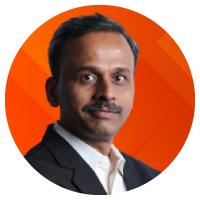 Uday Birajdar
Uday Birajdar
Uday Birajdar, Co-founder and CEO, Vyom Labs has 20+ years of experience in engineering, marketing, sales and business development. Since 2003 he has worked to develop a focused business in IT Infrastructure, Enterprise Service Management and Cloud space with automation and IT as-a-service as key elements.
The post Hyperautomation with Helix Remedyforce – Is it possible? appeared first on Vyom Labs.
]]>The post Do you know Kanban Board is now a reality in the BMC Helix ITSM solution? appeared first on Vyom Labs.
]]>Kanban boards visually depict work at various stages of an ITSM process using cards to represent work items and columns to represent each stage of the process.
Simply drag and drop the cards to change the status of the ITSM ticket.
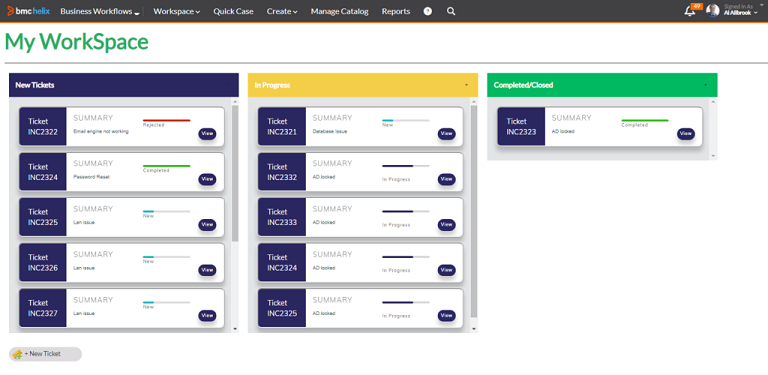
BMC Helix developers can develop a new application or can transform your existing ITSM running in two ways:
- Developing a codeless application
- Developing a code-based application
The development of codeless applications requires minimal programming knowledge or dependency on developers. Developers can create codeless applications that need less customization and are not complex. These applications consist of definitions and data only and do not include libraries.
The development of code-based applications requires the Helix Platform SDK, Helix Innovation Studio, and Maven archetypes. For code-based applications, we have developed custom components, custom API connectors, and extended the BMC Helix Platform capabilities.
Your ITSM can have your desired views on the Helix Platform. BMC Helix Platform is a cloud-based offering from BMC available through Amazon Web Services and BMC Cloud.
The key aspect of BMC Helix Platform / Innovation Suite is:
- Modern architecture to build applications
- Intuitive drag-and-drop design tools
[Related blog : Best Practices for ITSM Tool Implementation]
[Related blog : New Advances in ITSM platform in 2020]
Here are some more views of an ITSM application built using BMC Innovation Suite
ITSM application Card View
A beautiful layout of all your BMC Helix applications in the single console – CARD view
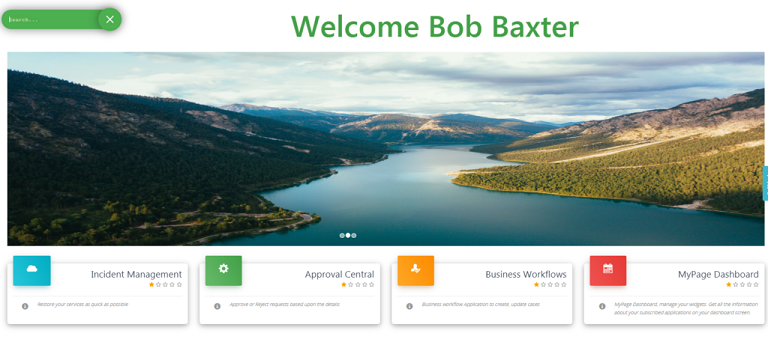
ITSM application Dashboard View
- Card Header Layout
- Footer Widget
- Affected Areas Map
- ITSM Ticket view
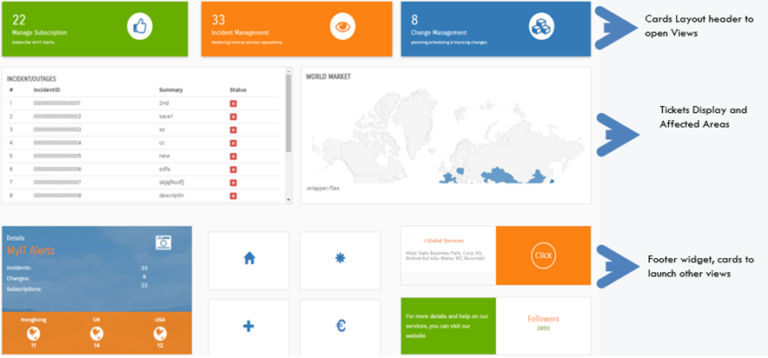
BMC Helix developers are the chief troupes in empowering successful digital transformation strategies and Vyom Labs has built in house team of developers and business analysts to build together an advanced digital service management applications using BMC Helix Innovation Suite.
Visit our Product pages for more info: BMC Digital Service Management
Reach out to us at info@vyomlabs.com or share your comments below!
About the Author:
 Juzer Saifee
Juzer Saifee
Juzer leads the ITSM Solution consulting team in Vyom Labs and he is recognized as a solution expert in BMC Helix ITSM & Digital Workplace through BMC PSEP Program. He is also ITIL V3 Certified Consultant and PRINCE2 Practitioner Certified.
He has an illustrious career over thirteen years in information technology and has served at BMC Software, Maersk Global Services, and Tata Consultancy Services. His technical expertise in IT Service Management, automation, and IT infrastructure management.
The post Do you know Kanban Board is now a reality in the BMC Helix ITSM solution? appeared first on Vyom Labs.
]]>The post How can multilingual support team and customer converse together in BMC Remedy? appeared first on Vyom Labs.
]]>By Delivering an Intuitive Language Translator
BMC Remedy ITSM or Helix ITSM is critical to the success of global enterprises. Delivering a dependable ITSM solution across country borders and varying cultures is an extraordinary challenge these companies face.
Questions these companies consider are: How can BMC Remedy ITSM achieve native language for regional service desk agents within one single instance? How should such a solution be built? What is the technical impact? This article provides a glimpse into the solution built by Vyom Labs.
BMC Helix ITSM right fit for Multilanguage users
BMC Helix ITSM is a fully internationalized environment: one can localize the labels, messages (system-generated messages), notifications, and the currency used in an application.
Why implement Language Translator on top of localized language?
Self-Service application or BMC Digital Workplace is highly tailored to meet the needs of a company’s end users. In regional locations, this includes providing an interface in the end user’s native language.
IT departments of global enterprises can’t expect all employees to use the matching language to make Service requests, so an Israeli support staff in a global company should be able to use BMC ITSM with a Hebrew interface and should be able to translate the user-generated messages within the ITSM console. Similarly, an Italy Support staff in a global company should be able to use BMC ITSM with a translator button within the same incident management console to translate the English text to Italian text.

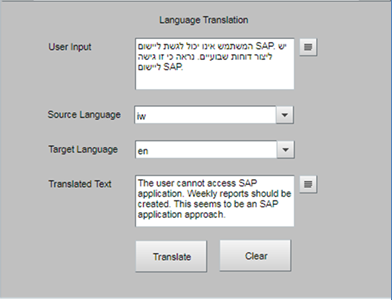
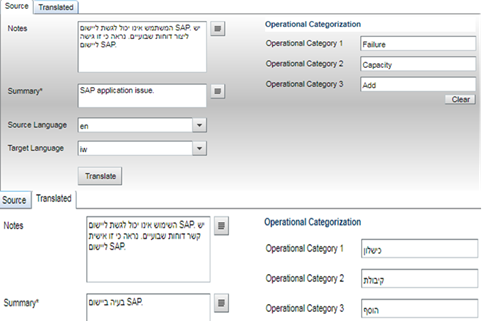
Technical Architecture of the Solution
Remedy ITSM supports multilingual logic, but what about translation on user-generated messages?
User-generated messages can be translated dynamically between languages within ITSM console using Google translator API.
Translation enables organizations to translate Text between languages using Google’s pre-trained or custom machine learning models.
Google Translation API readily integrates with BMC Helix ITSM
Google Translation API Basic instantly translates texts into more than one hundred languages for your BMC Remedy ITSM.
Here is the short video of how Remedy ITSM seamlessly works with Google translator API and translates the Text in English- > other languages -> English within the incident ticket and saves the ticket in the language support agent likings.
[Also Read: New Advances in ITSM Platform in 2020]
Conclusion
Providing localized BMC Helix ITSM is a must for Global companies. The most efficient way is to have language pack plus the language translator feature enabled, such that most of the rules are shared but the layout is country dependent and user-generated texts can be easily translated. The scope of translation is crucial in such projects and the requirements can be distinct between companies.
However, if one decides to deploy its multilingual, easily translated texts within the interface, BMC ITSM can make it a reality.
Reach out to us at info@vyomlabs.com or share your comments below!
About the Author:
 Juzer Saifee
Juzer Saifee
Juzer leads the ITSM Solution consulting team in Vyom Labs and he is recognized as a solution expert in BMC Helix ITSM & Digital Workplace through BMC PSEP Program. He is also ITIL V3 Certified Consultant and PRINCE2 Practitioner Certified.
He has an illustrious career over thirteen years in information technology and has served at BMC Software, Maersk Global Services, and Tata Consultancy Services. His technical expertise in IT Service Management, automation, and IT infrastructure management.
The post How can multilingual support team and customer converse together in BMC Remedy? appeared first on Vyom Labs.
]]>The post New Advances in ITSM platform in 2020 appeared first on Vyom Labs.
]]>Digitalization is rapidly changing the face of ITSM. The traditional service desk is evolving into AI-powered service management platform. Employees are demanding consumer world like experience which is intuitive, omnichannel, fast and seamless. Employee experience has taken a center stage now.
2019 was the year of change for IT Service Management. Artificial intelligence (AI) is integrated deep into the systems and powering business growth successfully. But, 2020 looks more focused on employee experience and integrated service management. According to Gartner reports, 40% of the enterprises will adapt AIOPS (Artificial Intelligence for IT operations) by 2022. AI-enabled customer-facing service desk support will increase by 25% by 2020 leveraging virtual customer assistant and chatbots. Let’s take a look at the new advances in the ITSM platform.
Integrated Service and Operations Management
IT Operations are becoming complex every day. Enterprises are bombarded with the inclusion of advanced technologies like multi-cloud, multi-device (IoT), multi-channel, DevOps, AI, ML, and chatbots. Such a vast universe of technologies is creating enormous complexity in the IT landscape. This call for an integrated solution to reduce simplify the management.
BMC Software has recently announced the industry’s first end-to-end integrated ITSM and ITOM platform which brings together the capabilities of ITSM and ITOM into BMC Helix.
Integrated solutions will enable IT teams to discover, optimize, remediate and deliver through an omnichannel for IT and business users. Such solutions will eliminate silos to make better-informed decisions and enhance the customer experience. It’ll also help in discovering unknown assets in multi-cloud, monitor & predict events, uncover & remediate security vulnerabilities and provide 360 degree intelligence environment.
Cloud, Containerization and Cognitive Services
Multi-cloud, Containerization and Cognitive services were some of the dominant trends in the ITSM world in 2019.
Multi-cloud has become reality. Customers are embracing multi-cloud strategies. Correspondingly, ITSM vendors are coming up with their cloud offerings apart from traditional on premise solutions. Moving to the cloud has its own advantages such as transferring upgrade responsibility to ITSM vendors, saving substantial costs of upgrades as well as eliminating day-to-day management of ITSM stack.
[Also Read: Cognitive Service Management]
There are certain advantages of containerization. Ease of porting between different cloud platforms, environment standardization and version control, isolation and optimum utilization of resources, faster speed make it a better technology than standard VM based solutions. ITSM vendors are including containers as an integral part of the offering.
Installation and deployment of complex ITSM stack get simplified by the use of containers.
Organizations have transformed themselves from “online” to “digital” and now to “cognitive” enterprises. This indeed can be seen as “Digital Maturity” in their digitization journey. Cognitive Service Management typically consists of use of technologies like AI, chat-bots, machine learning and Robotic Process Automation (RPA).
ITSM platform gets benefits from machine learning in several ways such as: predicting issues and problems proactively, improving search capabilities and knowledge management and finally auto-classification of service desk tickets. Historical ticket data is used in developing AI models which later can predict the classification as well as prioritization of tickets.
Chatbots have NLP (Natural Language Processing) built-in so virtual assistants can communicate in plain English language which in turn provides better self-service experience.
Getting key data out of unstructured emails is possible with the AI technology. Further, the intent and entity data is used in creating service desk tickets automatically.
This helps in simplifying complex catalogue navigation as user input can come now via emails or by chat.
Intelligent Technologies for Smarter Service Desks
With advances in RPA technologies, request fulfilment is happening automatically. Mundane tasks like password resets, share folder access, AD account creations, addition of IDs to mailing lists, service restarts etc. are getting resolved quickly using RPA. This quicker resolution lowers MTTR (mean time to resolve). RPA vendors are including various plugins within their platform so any automation script writing or programming work gets eliminated. All needed is configuration of plugins to develop workflows achieving various IT automation tasks.
This automation is helping to free up L1 (entry level support) bandwidth so service desks team could focus on higher level tasks. Reduction in L1 level resources results in lower service desk cost. Moreover, elimination of human errors, faster resolution time are additional benefits as well.
According to Gartner, by 2020, 80% of outsourced service desks for global enterprises will no longer require human service desk agents for the first contact.
Business is demanding IT to come up with new-age solutions
IT organizations have to move fast in embracing these new technologies which make ITSM more predictive, pro-active and automated.
Vyom Labs has been providing innovative and cutting-edge solution for ITSM.
We can be your partner in your automation journey.
Please visit our BMC Helix services to understand Vyom Labs various services and solution offerings.
The post New Advances in ITSM platform in 2020 appeared first on Vyom Labs.
]]>The post Top ITSM Trends To Look For In 2020 appeared first on Vyom Labs.
]]>Artificial Intelligence (AI) has been the buzz word for a long time now. AI has created a lot of hype in the last year and 2020 will bring some interesting applications in businesses. AI has come to a stage where even Robert Downey Jr. sees the need to learn and share the advancements through the YouTube series “The Age of AI”, after 10 years of Ironman journey.
AI is affecting every part of our lives, including IT Service Management. IT operations are connected to every other part of the business and thus ITSM plays an important role in the business to improve the overall performance. Here are the top ITSM Trends we feel will impact businesses in 2020. Let’s go!
Trend 1: Hyperautomation
Automation has become an integral part of digital businesses. But what tops the Gartner Top 10 Strategic Technology Trends for 2020? Hyperautomation. Hyperautomation is a combination tool and technologies like RPA, AI, Service Management, Analytics and other advanced tools and technologies working together to solve the bigger issues in the organization.
Servicedesk along with RPA & AI can work with teams to discover the processes that can be automated for greater impact. Hyperautomation engages everyone like subject matter experts to contribute in the automation process. It’ll also provide the analytics to measure and demonstrate the impact and ROI of automation.
Trend 2: People-First Approach
“People-Centric Smart Spaces” will be the phrase you’ll hear in this year a lot. Time is changing and 2020 will be more focused on improving employee engagement and providing a work-friendly environment to stay productive. Auto ticket assignment and resolution will keep the mundane tasks away from the IT team, leaving them with more challenging tasks at the workplace. Also, faster resolution and self-service options to employee issues will have a larger impact on employee productivity.
Trend 3: Enterprise Service Management in Focus
Collaboration from IT will play a vital role in success. Breaking down silos is important to achieve collaborated growth and IT operations will have more contribution in efficient business operations. The Forrester Wave: Enterprise Service Management 2019 highlights that different functions in the organization do the same supporting work as IT but in a different way. ESM focuses on using proven ITSM tools and processes to support other functions within an organization to create a true Enterprise Service Management solution. At some organizations, it’ll mean a shared services portal, to others it will be a joint onboarding process. ESM will lower cost, improve operational efficiency and happy customers.
Trend 4: AI-Powered Security
The increasing number of security threats is not only impacting global organizations but also smaller businesses. In an independent survey, 36% of the companies kept IT security as their top priority in 2020. Information security will be in the list of ITSM trends with more focus on corporate governance, risk management, and wider IT management.
New advancements in Artificial Intelligence and Machine Learning will help in the early detection of threats and closing the cybersecurity gaps in the system. AI will have a major impact on governance and complying with security compliances. According to Gartner, AI security will have three key perspectives:
- Protecting the AI systems like training data and ML models
- Using machine learning to enhance security defense by understanding the patterns and automating the part of security processes
- Identifying the use of AI by attackers and defending it
[Also read : Cognitive Service Management ]
Trend 5: Enhanced IT Support
Automation is majorly used in automating low hanging fruits in IT operations. Looks like service desk will be losing 30-40% of its tickets to automation. L1 support tasks such as password reset, salary slip requests, server restart will be completely taken over by automation. With the help of Chabot and AI, conversational IT request automation will be mainstream in IT support. A global organization with huge ticket data will have a better chance of successful automation of L1 requests, leaving humans with critical and productive tasks.
[Also read : ITSM Powered with AI becomes Intelligent Service Delivery for Service desk ]
So, you have got it. These are the top IT Service Management trends in 2020 to look for. If you have suggestions, please feel free to share in a comment.
IT service management is a backbone to any organization and Vyom Labs has been keeping it strong for many global organizations for more than 15 years. Have any questions or looking for a consultation in ITSM tools and services, get in touch.
The post Top ITSM Trends To Look For In 2020 appeared first on Vyom Labs.
]]>